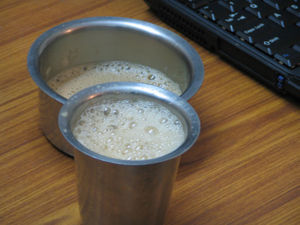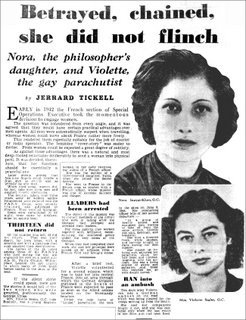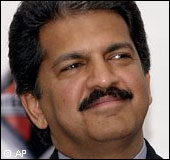There we were (year 1998), all suited and booted, the ‘few’ Indian families in Istanbul, fidgeting amongst other dignitaries waiting at the Hilton for the grand arrival of Indian president KR Narayanan. The occasion, ‘a breakfast with KRN’, arranged by the Indian consulate in Istamboul (as the consulate rubber stamp spelt it).
Meeting the president of the most populous country ‘one to one’, can you imagine that in India or for that matter any other place? Like my wife says, ‘ezhu ayalath kadakkan sammathikkila’ (I have tried to find out where & how that usage originated,, never figured it out – why seven neighbourhoods – so if anybody knows, please…)
Well, he made his grand arrival, accompanied by a number of ‘secret service’ chaps with microphones in the lapel and all that…his ADC (we were always told in our School days at Kazhakootam - that the ADC position is one we must aspire – President’s ADC) dressed smartly and standing next to him in the picture – Shoba, me and Arun. Our elder son Abi is missing in the picture, wonder where he wandered off so?
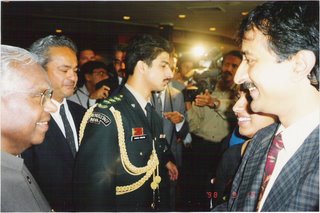 And the tete-a-tete?
And the tete-a-tete?
Me – ‘Namaskaram – kandathil valare santhoshamundu’
KRN- ‘ehe? Malayalai ano’? The surprise was evident… “Evidunna?”
Me – ‘Palakkad, Wife Kozhikode ninnanu’
KRN- ‘Aha, eniku Palakkad nallonam ariyam, Ivide kure Malayalikal undo’?
Me – ‘Illa, randu familye ullu, veroral undu, you’ll meet him also today’
KRN- ‘Shari, ennal - nice meeting you all...’
Then he moved on and had a similar quick chat with Shoba…about Calicut, life in Turkey etc.
Naturally Arun, the little boy was forgotten in the rush – you can see him in the picture entreating us to introduce him, with animated eyes…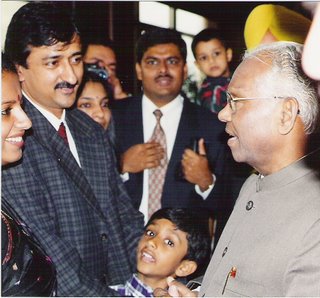
KRN moved away, Arun started to weep since he was not introduced & his hand was not shaken; So Shoba took him to KRN. He was all attention, “saramilla mone, come here” and shook his hand as well, after asking his name and patting his back.
Well, how’s that for an experience!!!
A quote from KRN
We are way behind when it comes to reading. I am not saying that people don't read but there is a need to make the younger generation develop a reading habit. After all, one acquires knowledge only through books. And, by books I mean fiction and non-fiction. Not just Harry Potter.
Meeting the president of the most populous country ‘one to one’, can you imagine that in India or for that matter any other place? Like my wife says, ‘ezhu ayalath kadakkan sammathikkila’ (I have tried to find out where & how that usage originated,, never figured it out – why seven neighbourhoods – so if anybody knows, please…)
Well, he made his grand arrival, accompanied by a number of ‘secret service’ chaps with microphones in the lapel and all that…his ADC (we were always told in our School days at Kazhakootam - that the ADC position is one we must aspire – President’s ADC) dressed smartly and standing next to him in the picture – Shoba, me and Arun. Our elder son Abi is missing in the picture, wonder where he wandered off so?
 And the tete-a-tete?
And the tete-a-tete?Me – ‘Namaskaram – kandathil valare santhoshamundu’
KRN- ‘ehe? Malayalai ano’? The surprise was evident… “Evidunna?”
Me – ‘Palakkad, Wife Kozhikode ninnanu’
KRN- ‘Aha, eniku Palakkad nallonam ariyam, Ivide kure Malayalikal undo’?
Me – ‘Illa, randu familye ullu, veroral undu, you’ll meet him also today’
KRN- ‘Shari, ennal - nice meeting you all...’
Then he moved on and had a similar quick chat with Shoba…about Calicut, life in Turkey etc.
Naturally Arun, the little boy was forgotten in the rush – you can see him in the picture entreating us to introduce him, with animated eyes…

KRN moved away, Arun started to weep since he was not introduced & his hand was not shaken; So Shoba took him to KRN. He was all attention, “saramilla mone, come here” and shook his hand as well, after asking his name and patting his back.
Well, how’s that for an experience!!!
A quote from KRN
We are way behind when it comes to reading. I am not saying that people don't read but there is a need to make the younger generation develop a reading habit. After all, one acquires knowledge only through books. And, by books I mean fiction and non-fiction. Not just Harry Potter.








